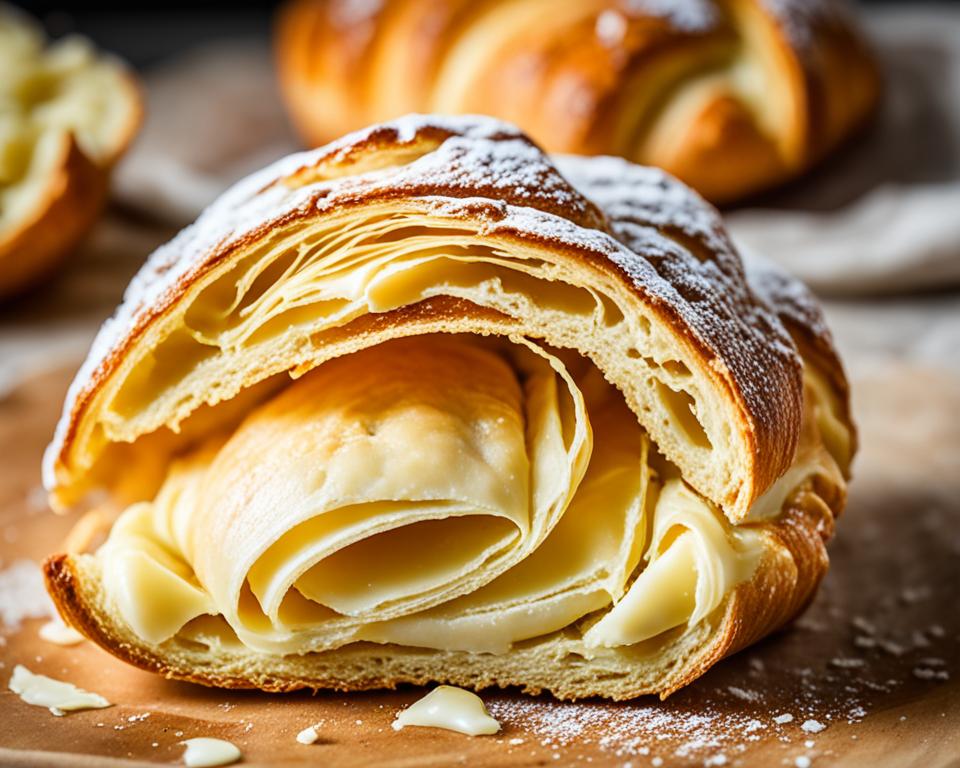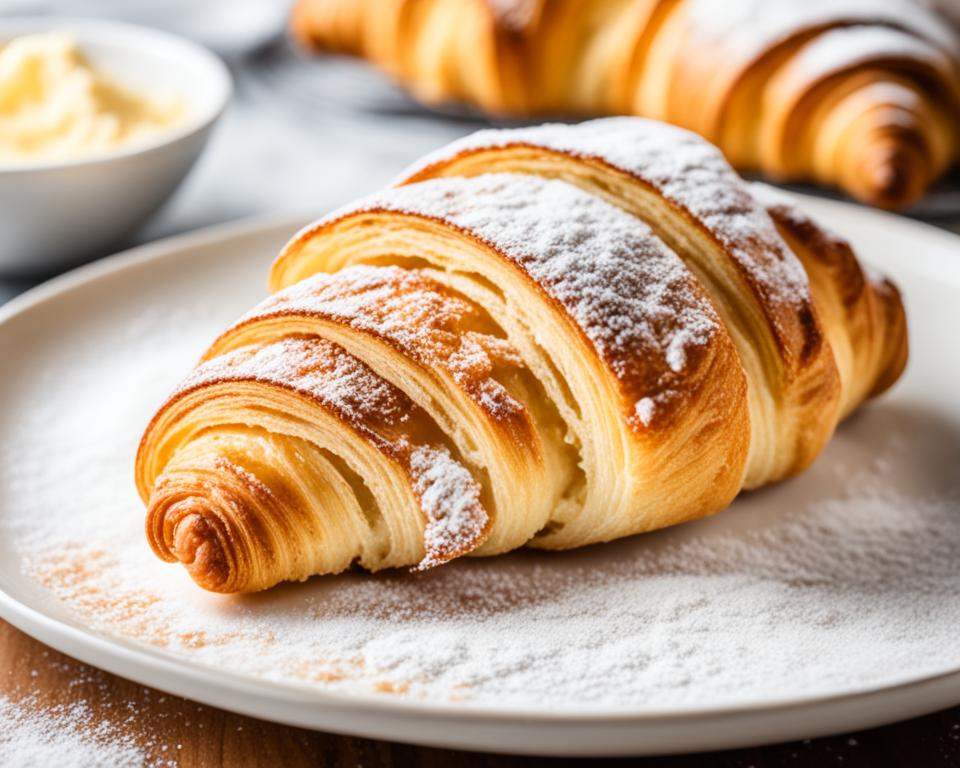
Croissant bread is a beloved French pastry loved by people all over the world. It’s known for its flaky, buttery taste. This makes it a top pick for breakfast, brunch, or any time you want a treat. We’ll explore how to make croissant bread, its history, the special techniques, and the many tasty variations.
Read interesting things at : web-quanto
Key Takeaways
- Croissant bread is a classic French pastry known for its flaky, buttery texture.
- The origins of croissant bread can be traced back to the 13th century in Austria, and it later became a beloved staple in French bakeries.
- Mastering the layered dough technique, also known as lamination, is crucial for achieving the signature flakiness of croissant bread.
- Butter plays a vital role in the texture and flavor of croissant bread, contributing to its melt-in-your-mouth quality.
- Shaping croissant dough into the classic crescent shape is a labor of love, requiring skill and patience.
The Art of Croissant Bread
Tracing the Origins of a French Delight
Croissant bread is a key part of the viennoiserie family. It has a long history starting in the 13th century. Austrian bakers first made it, but French bakers made it famous.
Mastering the Layered Dough Technique
The secret to a great croissant is in laminating the dough. This means layering butter between sheets of dough for a flaky texture. French bakeries use this butter layered dough method. It takes a lot of practice to get it right.
This hard work makes a viennoiserie that looks and tastes amazing. Every bite reveals layers of soft, buttery dough. It smells and tastes heavenly, making croissant lovers all over the world adore it.
“The perfect croissant is a work of art, a harmonious blend of flaky, buttery layers that melt in your mouth.”
The French bakery-style croissant is perfect for breakfast, a snack, or dessert. It’s a classic that still charms and pleases those who love laminated dough baking.
Croissant Bread: The Epitome of Flakiness
The true mark of a great croissant is its flaky, airy texture that feels like it melts in your mouth. This comes from the hard work of laminating the dough. This makes many thin layers that puff up in the oven, making the croissant both light and rich.
Making the perfect flaky pastry shows a baker’s skill and care. The dough must be folded and rolled with precision. It also needs rich, creamy butter to create the famous puff pastry look. This makes a crescent shaped treat that looks great and tastes amazing.
“The flakiness of a croissant is a testament to the baker’s mastery of the craft. Each bite is a revelation of perfectly executed layers of dough and butter.”
Getting the dough flaky is hard work. It needs patience, focus, and a good understanding of laminated doughs. The baker must watch the temperature and humidity closely during proofing and baking. This helps keep the layers thin and makes the flaky pastry perfect.
The croissant is great for breakfast, a snack, or a fancy dessert. It shows how much people love puff pastry. And it highlights the talent of those who make these tasty treats.
Ingredients: The Key to Perfect Croissants
At the heart of a captivating croissant lies the premium quality ingredients used in its preparation. Chief among them is butter, which plays a crucial role in defining the pastry’s signature flavor and flakiness. The butter layered dough is meticulously incorporated into the dough through the process of lamination. This creates the distinct layers that set french bakery croissant bread apart from other pastries.
The Role of Butter in Croissant Bread
Butter is the hallmark of a truly exceptional croissant. Its rich, creamy texture and high-fat content are essential in achieving the coveted flakiness that makes this French delicacy so alluring. The layering of the butter within the dough creates a mesmerizing interplay of crisp, golden crust and soft, pillowy interior with each bite.
Beyond its textural contribution, butter also lends a depth of flavor to croissant bread that is simply unparalleled. The subtle nutty notes and luxurious mouthfeel of high-quality butter elevate the overall experience. Making each croissant a true indulgence for the senses.
“Butter is the soul of French cuisine, and the croissant is the perfect manifestation of that philosophy.”
Shaping Croissants: A Labor of Love
Making the perfect croissant is a labor of love. The shaping step is key to its success. It involves rolling and cutting the crescent shaped dough into its iconic form. Each movement needs care and detail. This shows the dedication and skill of French bakers who have made viennoiserie a culinary art.
Shaping the croissant dough is like a dance. You roll it into a thin sheet, then cut it into triangles for the crescent shape. Keeping the flaky, buttery layers is crucial for the croissant’s texture.
- Roll the dough into a thin, rectangular sheet.
- Cut the dough into triangles to create the crescent shape.
- Carefully shape the dough, ensuring the layers remain intact.
- Gently stretch and fold the dough to achieve the desired form.
- Transfer the shaped croissants to a baking sheet, taking care not to disturb the delicate structure.
| Step | Description | Importance |
|---|---|---|
| Dough Shaping | Carefully rolling, cutting, and forming the dough into the iconic crescent shape | Crucial for maintaining the flaky, buttery layers that define the croissant’s texture |
| Dough Transfer | Gently transferring the shaped croissants to a baking sheet without disturbing the delicate structure | Ensures the croissants maintain their shape and rise properly during baking |
Shaping croissant dough is a labor of love. It requires skill and attention to detail. This process shows the dedication of French bakers. They have turned the simple croissant into a culinary masterpiece.
“The true test of a croissant’s quality lies in the delicate, flaky layers that emerge from the oven.” – Chef Émile Durand, renowned French pâtissier
The Proofing Process: Patience is Virtue
The proofing stage is key in making laminated dough for french bakery treats like croissants. It’s when butter and dough layers mix well. This lets gluten relax and the pastry get fluffy and tall.
For bakers aiming for the perfect croissant, mastering proofing is crucial. It’s all about patience. Let the dough rise slowly, don’t rush it.
Achieving the Perfect Rise
Proofing is where the magic is. As the dough rests, yeast makes it rise. This makes the layers puff up and get bigger. This is what makes croissants light and fluffy.
- Good proofing makes the pastry tall and flaky.
- Too quick proofing leads to a dense, flat croissant.
- Patience is important, letting the dough rise slowly, for a few hours, is best.
Learning to proof well lets bakers bring out the best in laminated dough. They can make french bakery treats that are truly amazing.
Baking Croissants: Mastering the Oven
The final step in making croissants is baking them. This turns the dough into the golden, buttery treats we love. To get it right, you need to know about oven temperature, baking time, and steam injection. These elements work together to make the french bakery delight we all know and love.
When baking bakery delicacy croissants, precision is crucial. The oven should be set between 375°F and 400°F. This ensures the dough rises and gets that flaky texture we all adore. The baking time also matters, lasting from 15 to 20 minutes, depending on the croissant’s size and shape.
Using steam is a secret to baking amazing croissants. Steam in the oven during the first part of baking makes the crust crisp and golden. It also keeps the inside soft and airy. This method is key to making the perfect croissant, just like in traditional french bakery shops.
“Baking croissants is an art form that requires patience, precision, and a deep understanding of the science behind the perfect crumb and crust.”
With the right techniques and attention to detail, bakers can become experts at making croissants. Each bakery delicacy they bake will show off the French culinary tradition.
Variations on the Classic Croissant Bread
The traditional croissant is a favorite, but now, croissant bread comes in many new flavors. Bakers have gotten creative, making croissant types for everyone. This breakfast treat has turned into a special bakery delicacy.
Sweet and Savory Fillings Galore
There are sweet croissants filled with chocolate, almonds, and fruits. But there’s more. Savory croissants with ham, cheese, or other ingredients are also popular. They’re perfect for a tasty breakfast treat or a fancy bakery delicacy.
- Chocolate-Filled Croissants
- Almond Croissants
- Fruit-Stuffed Croissants
- Ham and Cheese Croissants
- Spinach and Feta Croissants
These new takes on croissant bread have made it even more popular. Now, it’s a top choice for breakfast, brunch, and more.
“The beauty of croissant bread lies in its versatility – it’s a canvas that allows bakers to unleash their culinary artistry, crafting delightful variations that cater to every palate.”
Croissant Bread: A Versatile Treat
Croissant bread has grown from a favorite breakfast item to a versatile treat for any time of day. It’s flaky and buttery, making it perfect for any event. This bakery delight can make any moment special.
Enjoy it with a rich coffee or use it for a savory sandwich. The croissant’s light texture and unique taste make it great for breakfast, a snack, or as a side dish.
This bread is not just for eating alone. It can be turned into many creative dishes. You can fill it with sweet chocolate or savory ingredients, making it a versatile choice.
| Croissant Dish | Description |
|---|---|
| Croissant Sandwich | A croissant filled with a variety of savory ingredients, such as ham, cheese, or vegetables, making it a satisfying lunch or snack option. |
| Croissant French Toast | Slices of croissant dipped in a custard-like mixture and grilled, creating a delightful breakfast or brunch dish. |
| Croissant Bread Pudding | Cubed croissant pieces baked in a custard mixture, resulting in a rich and indulgent dessert. |
Croissant bread’s versatility shows why it’s so loved and creative in the kitchen. It’s great for breakfast, a snack, or dessert. This flaky, buttery treat always impresses and makes meals special.
“Croissants are the ultimate bakery delicacy, offering a perfect balance of flakiness and buttery richness that can be enjoyed in so many delightful ways.”
Pairing Croissants: Beverages and More
Turning a simple breakfast treat like a croissant into a special experience is fun. The right pairing can make a croissant more than just a pastry. You can enjoy it with a strong coffee, fancy teas, or even sparkling wines.
Finding the perfect drink to go with a croissant is exciting. The mix of the croissant’s texture and the drink’s aroma is amazing. It makes eating together a joy.
For a classic morning treat, try a croissant with fresh coffee. The coffee’s strong taste is a great match for the croissant’s buttery feel. It’s a perfect balance.
If you want something fancier, try specialty teas. Teas like Earl Grey or Jasmine go well with the croissant’s light taste. Or, a strong black tea can match the croissant’s richness.
For a fancy touch, add a sparkling wine or champagne. The bubbles and fruity taste of the drink go well with the croissant. It makes for a luxurious treat.
Whether you like a simple coffee and croissant or want to try something new, there are many choices. Finding the best drink for your breakfast treat is a fun adventure. It can make enjoying a croissant even more special.

| Beverage | Pairing Notes |
|---|---|
| Coffee | The robust, slightly bitter notes of coffee provide a delightful contrast to the buttery, flaky croissant. |
| Tea | Delicate, aromatic teas like Earl Grey or Jasmine can accentuate the delicate flavors of the croissant, while robust black teas can stand up to its richness. |
| Sparkling Wine/Champagne | The effervescence and subtle fruity notes of bubbly can complement the buttery goodness of the croissant, creating an indulgent pairing. |
The Allure of Fresh, Warm Croissants
The smell of buttery, flaky pastry fills the air, making your mouth water. For many, eating a warm, fresh bakery delicacy croissant is a special moment. It takes them straight to a Parisian café.
The first bite is satisfying, with a crunch that leads to a soft, melting inside. This creates a unique sensory experience.
Creating a Sensory Experience
A freshly baked croissant engages all your senses. Its golden, crisp outside and delicate layers catch your eye. The smell of butter and yeast fills your nose.
When you bite into it, the crunch turns into a soft, pillowy inside. This melts in your mouth, offering a rich, subtly sweet flavor.
“There’s nothing quite like the experience of indulging in a warm, buttery croissant straight from the oven. It’s a moment of pure indulgence that transports you to the heart of a Parisian café.”
Enjoying a croissant is more than just eating. It’s about tearing off flaky pieces, savoring each bite, and enjoying it with coffee or tea. This creates a pause in your day, a moment of pure pleasure.
Whether it’s for breakfast, a snack, or dessert, the fresh, warm croissant delights your senses. It shows the skill and love of french bakery traditions. This delicacy delights both new and experienced lovers alike.
Croissant Bread: A Timeless Indulgence
The french bakery is famous for its bakery delicacy, croissant bread. This pastry has stood the test of time. It has become a favorite around the world.
Croissant bread’s lasting charm shows the skill of bakers. They work hard to make this treat perfect. From the classic buttery croissant to new twists, it brings back memories and joy.
The flaky, golden crust and rich, luxurious interior define a great croissant. It’s a mix of tradition and new ideas. This pastry delights both experts and newcomers.
“A croissant is not just a breakfast pastry – it’s a work of art, a culinary masterpiece that transcends the boundaries of time and culture.”
Enjoy a croissant with coffee, tea, or just by itself. It’s a treat that brings back memories and celebrates French baking. Its timeless charm will continue to enchant people for years.
Mastering Croissant Bread at Home
Making flaky pastry might seem hard, but with the right skills and practice, you can do it at home. Learn about butter layered dough and the laminated dough process. This way, you can make the magic of Parisian croissant bread in your kitchen.
The secret to great croissants is in the dough and butter mix. Folding thin butter layers into the dough is key for that flaky texture. Being patient and careful during proofing helps create a delicate pastry.
When it’s time to shape and bake, be gentle. Roll and fold the dough carefully, and bake at the right temperature. With practice, you’ll get the hang of making croissant bread and add a touch of Paris to your kitchen.
| Essential Croissant Bread Techniques | Tips for Success |
|---|---|
|
|
With patience, practice, and a love for baking, you can become a pro at croissant bread. Enjoy the joy of making and eating a flaky and buttery croissant at home.

“The perfect croissant is a study in contrasts – crisp on the outside, tender and light within, with the unmistakable aroma of fresh-baked bread and butter.”
Conclusion
The croissant bread is a true masterpiece, showing the skill and art of French bakers. It has become popular worldwide for its flaky and buttery taste. People love it for breakfast, a snack, or as a special treat.
This bread is a key part of French food culture. It inspires bakers and delights those who try it with its flaky pastry taste.
The making of croissant bread is a story of art, patience, and perfecting each step. Every detail, from dough layering to baking, makes this French treat special. The mix of butter, flour, and traditional methods creates its golden crust and soft inside.
As we end our look at croissant bread, we value French baking more. Whether you’re a fan or new to croissants, their charm will keep drawing you in. It’s a symbol of French culinary greatness.






